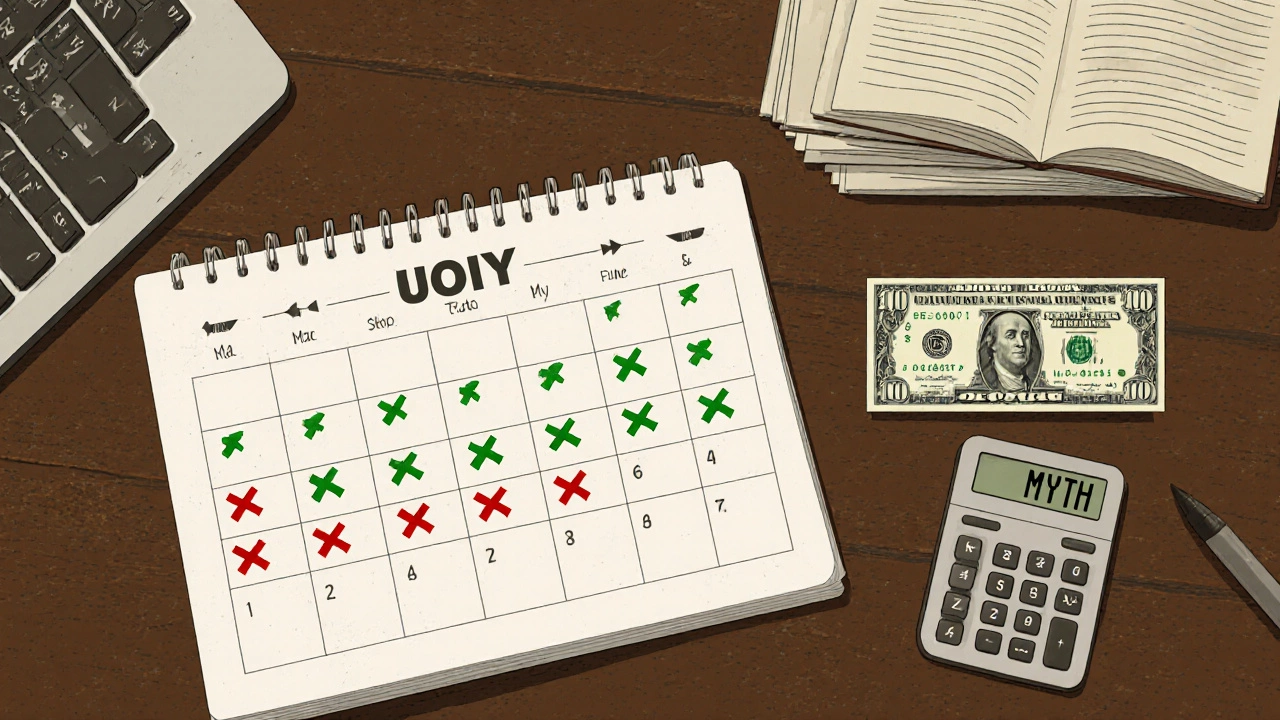Day Trading Profit Calculator
Realistic Expectations
Based on SEC data: 80% of retail traders lose money. Average profitable trader makes $20-$100/day after months of practice. Most days earn $0.
Calculate Your Daily Net Profit
Enter your trading parameters based on real-world day trading conditions
Daily Profit Analysis
Costs include: $15 commission, $10 data fees, $20 slippage
Most people think day trading with a $10,000 account is a fast track to quick cash. You see videos of traders flipping stocks, making $500 in an hour, and wonder why you’re still stuck in your 9-to-5. But the reality? The average day trader with a $10,000 account doesn’t make anything close to that-most lose money, and those who do profit rarely make consistent daily gains.
Day trading isn’t a job-it’s a skill you have to earn
Day trading isn’t like opening a lemonade stand. You don’t just buy low, sell high, and collect profit. It’s a high-pressure, fast-moving game that demands discipline, strategy, and emotional control. A $10,000 account sounds like a lot until you realize you’re trading with real money, real risk, and real consequences.
According to the U.S. Securities and Exchange Commission (SEC), about 80% of retail day traders lose money over time. That’s not a rumor-it’s a documented fact based on brokerage data from firms like TD Ameritrade and Interactive Brokers. The average profitable trader with a $10,000 account makes between $20 and $100 per day, and only after months, sometimes years, of practice.
That’s not $500. That’s not even $200. That’s $20 on a good day. And most days, they make $0.
What actually drives daily profits?
Profit isn’t about how much you risk-it’s about how well you manage risk. A $10,000 account lets you trade up to $30,000 on margin under Pattern Day Trader rules, but that doesn’t mean you should. Most successful traders risk only 1% of their account per trade-that’s $100 on a $10,000 account.
If you’re aiming for a 1:2 risk-reward ratio (common among pros), you’re targeting $200 profit per trade. But you need to win at least 4 out of 10 trades just to break even after commissions and fees. That’s not easy. Markets don’t move in your favor 40% of the time unless you’ve spent hundreds of hours learning price action, volume patterns, and market sentiment.
Let’s say you make 3 trades a day, risk $100 each, and win 40% of them. That’s 1.2 winning trades per day. At $200 profit each, that’s $240. But you lose $100 on 1.8 losing trades-that’s $180 in losses. Net profit? $60 a day. Sounds good? Now subtract $15 in commissions, $10 in data fees, and $20 in slippage. You’re down to $15. That’s your average daily take.
Why most traders fail before they even start
The biggest mistake? Thinking you can replicate what you see on YouTube. Those “I made $3,000 today!” clips are cherry-picked highlights. They don’t show the 27 days before that when they lost $1,200. They don’t show the sleepless nights, the emotional breakdowns, or the time spent studying charts while everyone else is watching TV.
Most beginners jump in with no plan. They buy a stock because it’s trending on Reddit. They chase pumps. They hold losers hoping they’ll bounce back. That’s gambling, not trading.
Real traders use a written plan: entry point, exit point, stop-loss, position size. They track every trade in a journal. They review mistakes weekly. They don’t trade when they’re tired, angry, or excited. They wait for setups that match their edge.
And even then, they don’t expect to win every day. Some days, they don’t trade at all. That’s part of the strategy.

What does a realistic ,000 day trader’s month look like?
Let’s say you’re one of the 20% who actually makes money. You trade 20 days a month. You average $50 in net profit per day. That’s $1,000 a month. Sounds decent? Now think about this:
- You’re spending 6-8 hours a day in front of the screen.
- You’re paying $50-$100 a month in tools and data.
- You’re paying taxes on every dollar of profit.
- You’re not getting health insurance, paid leave, or a 401(k).
That $1,000 isn’t free money. It’s the result of intense focus, constant learning, and emotional resilience. Compare that to a part-time job paying $15/hour for 20 hours a week-that’s $600 before taxes. You’re making more as a trader, but you’re working twice as hard with no safety net.
And that’s the best-case scenario.
Can you turn $10,000 into $100,000?
Yes. But not by trying to make $500 a day.
One trader I know started with $8,000 in 2022. He didn’t trade every day. He traded only when the setup was perfect. He averaged 10% monthly returns. That’s $800 in month one, $880 in month two, $968 in month three. After 18 months, he had $40,000. He didn’t quit his job. He didn’t brag on social media. He just kept showing up, learning, and sticking to his rules.
That’s the difference between fantasy and reality.

What you need to succeed (not what you think you need)
You don’t need a fancy trading platform. You don’t need a $500/month signal service. You don’t need to watch CNBC all day.
You need:
- A simple, repeatable strategy (like price action on 15-minute charts)
- A trading journal (track every trade-win or lose)
- Strict risk rules (never risk more than 1% per trade)
- Patience to wait for your edge
- Emotional control to walk away when you’re on tilt
And most of all-you need to stop chasing quick wins. The market doesn’t reward greed. It rewards consistency.
Bottom line: What’s the real average daily profit?
For the vast majority of traders with $10,000 accounts? $0.
For the top 5% who’ve spent 6-12 months learning? $20-$100.
For the 1% who treat it like a profession? $150-$300 on a good month, with weeks of $0.
There’s no secret formula. No magic indicator. No insider tip that turns $10,000 into $1,000 a day. If someone tells you otherwise, they’re selling a dream-not a strategy.
If you’re serious about day trading, start by learning how to lose. Then learn how to lose less. Then learn how to win just enough to cover your costs. That’s the only path that leads somewhere real.
What happens if you lose your $10,000?
It happens. All the time.
One trader I spoke with lost his entire $10,000 in three weeks because he kept doubling down after losses. He thought he was “due for a win.” He wasn’t. He was just playing Russian roulette with his savings.
Don’t trade with money you can’t afford to lose. That’s not advice-it’s survival.
If you lose your $10,000, you don’t get a second chance unless you rebuild. And rebuilding means starting from zero-with humility, not hope.


